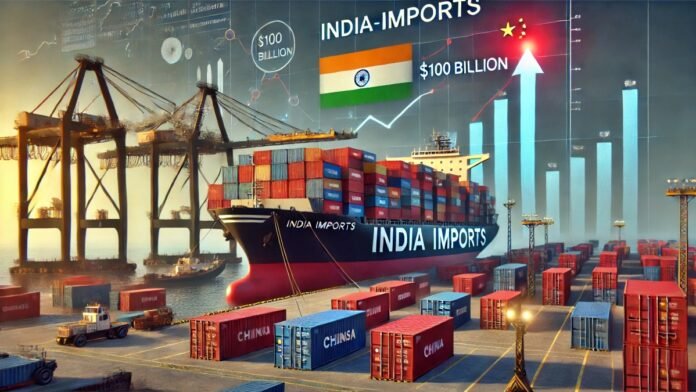
Key Points:
- India’s imports from China are projected to surpass $100 billion by February 2025, likely breaking the record of $101.73 billion set in FY 2023-24.
- The trade deficit with China has widened to $83.52 billion in the first 10 months of FY 2024-25, as exports to China plummet by 14.85%.
- Key imports include electronic components, chemicals, and machinery, which are critical for India’s manufacturing sector.
- Experts attribute the growing deficit to India’s dependence on Chinese goods for intermediate and capital inputs, coupled with declining export competitiveness.
- Calls for policy reforms and diversification of supply chains are intensifying as India seeks to reduce reliance on Chinese imports.
New Delhi: India’s trade relationship with China continues to deepen, with imports from its northern neighbor expected to exceed $100 billion by February 2025. According to data from the Commerce Ministry, imports from China reached $95.01 billion between April 2024 and January 2025, marking a 10.6% year-on-year increase. This surge has widened India’s trade deficit with China to $83.52 billion during the same period, nearly matching the total deficit of $85.06 billion recorded in FY 2023-24.
While Chinese goods play a crucial role in supporting India’s manufacturing ecosystem, the growing trade imbalance has raised alarms about economic dependency and industrial self-reliance.
Imports Surge While Exports Decline
India’s imports from China encompass a wide range of products, including electronic components, telecom equipment, chemicals, and pharmaceutical raw materials (APIs). These items are essential for domestic industries under initiatives like “Make in India.” However, India’s exports to China—primarily iron ore, marine products, petroleum products, and organic chemicals—have seen a sharp decline.
- Imports: Up by 10.6%, reaching $95.01 billion (April 2024–January 2025).
- Exports: Down by 14.85%, totaling just $11.48 billion in the same period.
- January 2025 Figures: Imports surged by 17% year-on-year to $10.48 billion, while exports fell by a staggering 31% to $483 million.
This imbalance has further tilted the trade relationship in favor of China, exacerbating concerns over India’s economic vulnerability.
Why Are Imports from China Increasing?
- Dependence on Intermediate Goods:
- A significant portion of imports consists of intermediate goods like APIs for pharmaceuticals, auto components, and electronics parts used in domestic manufacturing.
- These items are critical for producing finished goods for both domestic consumption and export markets.
- Cost Competitiveness:
- Chinese goods remain highly competitive due to lower production costs and government subsidies in sectors like electronics and solar equipment.
- Weak Rupee:
- The depreciation of the Indian rupee against the US dollar has made imports more expensive but has not significantly boosted exports due to structural inefficiencies.
- Limited Domestic Alternatives:
- Despite efforts under “Atmanirbhar Bharat,” India lacks sufficient domestic production capacity in several high-tech sectors like semiconductors and machinery.
Trade Deficit: A Growing Concern
India’s overall merchandise trade deficit rose to $242.99 billion between April 2024 and January 2025, up from $206.29 billion during the same period last year. Petroleum imports alone accounted for $154.83 billion (up by 6.42%), contributing significantly to the widening deficit.
The imbalance with China remains the largest contributor to this deficit:
- In FY 2023-24, bilateral trade reached a record $136.2 billion.
- Imports from China accounted for over 15% of India’s total imports during this period.
Policy Reforms Needed to Address Dependency
Experts have called for urgent measures to reduce reliance on Chinese imports and improve export competitiveness:
- Diversification of Supply Chains:
- Strengthening trade partnerships with countries like the US, EU members, Japan, and South Korea through Free Trade Agreements (FTAs).
- Encouraging investments in local manufacturing through expanded Production Linked Incentive (PLI) schemes.
- Boosting Domestic Manufacturing:
- Enhancing support for industries like electronics, chemicals, and pharmaceuticals through infrastructure development and tax incentives.
- Promoting semiconductor manufacturing under initiatives like “Digital India.”
- Strategic Tariffs and Anti-Dumping Measures:
- Imposing tariffs on cheap Chinese imports that harm domestic industries while ensuring compliance with WTO norms.
- Strengthening Export Sectors:
- Increasing value-added exports such as engineering goods instead of low-margin commodities like iron ore.
Global Implications: A Balancing Act
India’s growing trade imbalance with China also has geopolitical implications:
- The dependency on Chinese goods raises concerns about supply chain disruptions due to geopolitical tensions or trade restrictions.
- Efforts to diversify supply chains align with global trends as countries seek alternatives under “China Plus One” strategies.
- However, experts caution that completely decoupling from China is neither feasible nor economically prudent in the short term.
A Call for Strategic Action
As India inches closer to becoming the world’s third-largest economy, its growing dependency on Chinese imports poses significant challenges for economic sovereignty and industrial growth. While initiatives like “Make in India” aim to reduce this reliance, structural reforms are needed to address deep-rooted inefficiencies in domestic manufacturing.
The upcoming Union Budget 2025 presents an opportunity for policymakers to introduce measures that promote self-reliance while fostering global trade partnerships. With India poised at a critical juncture in its economic journey, balancing growth aspirations with strategic autonomy will be key to navigating its complex relationship with China effectively.



















































